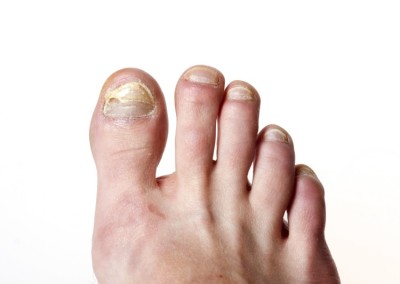Unless we’re cutting our toenails, we usually don’t give them a second thought, but that can change the moment you get a toenail infection. Toenail infections can be painful and lead to bigger problems if left untreated, so it’s important to attack the issue head on. Today, we take a closer look at toenail infections, and we share some treatment techniques.
Toenail Infections
 A toenail infection is actually caused by a fungus that attacks the nail bed. In fact, it’s usually caused by the same fungus that causes Athlete’s Foot. Typically this fungus enters your nail bed through a cut in your skin, in the nail, or through another opening (i.e. cutting your nail down too far).
A toenail infection is actually caused by a fungus that attacks the nail bed. In fact, it’s usually caused by the same fungus that causes Athlete’s Foot. Typically this fungus enters your nail bed through a cut in your skin, in the nail, or through another opening (i.e. cutting your nail down too far).
Because it’s generally caused by the same fungus that leads to Athlete’s Foot, toenail infections occur in a very similar manner. People can contract a toenail infection by walking barefoot in warm, damp areas, like a public pool or locker room. Additionally, since the fungus can spread from person-to-person, someone can develop a toenail infection after sharing a towel or other personal items.
Symptoms of Toenail Infection
If you think you have a toenail infection, you may be suffering from some of the following symptoms:
- Yellowing of the toenail
- Nail thickening
- The nail cracks or splits easily
- Pain in the nail while walking or wearing shoes
Treatment of Nail Infections
If you think you have a nail infection, you’ll want to treat the problem right away, especially if you have diabetes or a weak immune system, as these conditions can lead to serious complications. Additionally, if left untreated, the fungal infection could cause permanent damage to your nail bed.
If your doctor diagnoses you with a toenail infection, he’ll likely prescribe an antifungal medication. This usually comes in the form of a cream, lotion or even nail polish. In addition to antifungal medication, here are some ways to help treat your toenail infection:
- Wash and dry your feet when you wake up and before bed.
- Wear sandals to allow moisture to escape.
- Ensure all closed-toe shoes are dry.
- Wear socks, and change them if they get sweaty.
- Avoid sharing personal care items, like nail clippers.
- Wear sandals or flip flops in wet public areas, like locker rooms or showers.
If you suspect you have a toenail infection, it’s best to consult a foot specialist. They’ll be able to diagnose the problem and prescribe a personalized treatment plan to help stop the infection from worsening.